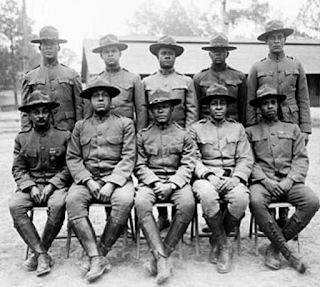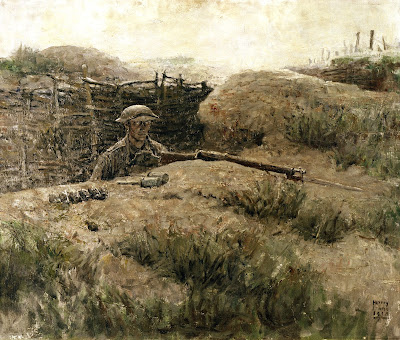 |
| The Sentry by Harvey Dunn, National Archives P3752 |
After 1,567
days, the Great War ended at the 11th hour of the 11th day of the 11th month of
1918. And yet on the last morning of the war, over 2,700 men died on the
Western Front.
As early as
August of 1918, German General Ludendorff had told his staff that Germany could
not win the war, and in late September, Generals Ludendorff and Hindenburg
agreed that they must seek an armistice.
The Kaiser was informed on September 30th, and on October 4th Germany contacted American president Woodrow Wilson, asking for terms based on
his Fourteen Points. Turkey agreed to peace
terms on October 30th, and Austria-Hungary sought an armistice on
November 3rd, but the German delegation didn’t meet to discuss an
armistice with the French until late in the evening of November 7th. By now, rumors of peace were everywhere.
 |
| Armistice celebration in London |
Many of the Allies’
generals were not in favor of a negotiated peace; their armies were finally
making gains, and they wished to pursue the fight, pushing their advantage to
force Germany’s unconditional surrender. In a railway carriage at Compiègne,
the German delegation had very little room to negotiate and were forced to
accept nearly all terms imposed by the Allies, including the provision that
within 14 days, they would evacuate and return all occupied territory and cede
their rights to Alsace-Lorraine. The Armistice was finally signed at 5:10 am on
the morning of November 11th and took effect less than six hours
later.
Along the
Western Front, German troops celebrated the night of November 10th,
shooting off flares and rockets. On the
morning of November 11th, a radio broadcast from the Eiffel Tower at
5:40 am announced the upcoming peace, and London received the news before 6:00
that morning.
Although nearly
everyone knew in advance that the war was over, even the most conservative
estimates acknowledge that the casualties from both sides on the war’s last day
reached nearly 11,000. At least 2,738 men
died on November 11th trying to take German positions that had already
been ceded to the Allies. As historian Joseph E. Persico explains,
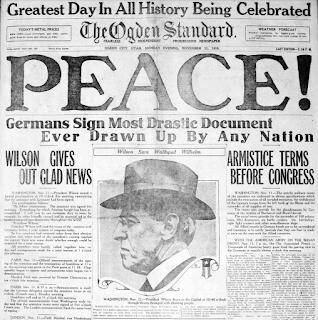 Putting
these losses into perspective, in the June 6, 1944 D-Day invasion of Normandy,
nearly twenty-six years later, the total losses were reported at 10,000 for all
sides. Thus the total Armistice Day casualties were nearly 10 percent higher
than those on D-Day. There was, however,
a vast difference. The men storming the Normandy beaches were fighting for victory.
Men dying on Armistice Day were fighting in a war already decided.”*
Putting
these losses into perspective, in the June 6, 1944 D-Day invasion of Normandy,
nearly twenty-six years later, the total losses were reported at 10,000 for all
sides. Thus the total Armistice Day casualties were nearly 10 percent higher
than those on D-Day. There was, however,
a vast difference. The men storming the Normandy beaches were fighting for victory.
Men dying on Armistice Day were fighting in a war already decided.”*
It is nearly
impossible to imagine the anxiety of the men who had survived and knew the end
was only hours away. German soldier Georg Bücher had fought on the Western
Front since 1914. He recalled,
It
was all the harder for us since we knew the end could not be far off. We ducked at the sound of every
explosion—which we had never bothered to do before. The old hands fought for the deepest, safest
dug-outs and did not scruple to leave to the young recruits the hundred and one
things which were risky….The thought of an attack was more terrifying to them
than to the young soldiers who were still so inexperienced, so touchingly
helpless, yet in spite of everything, so willing.**
American
Lieutenant Harry Rennagel, writing to his family, remembered his unit’s
astonishment at learning they were to attack on that last morning. When a shell
exploded near him at 10:55 a.m., he was spared, but discovered five of his
“best men” had been hit:
One
fatally injured, hole near heart, two seriously injured and the other two badly
hurt. We took care of the injured men and then I knelt beside the lad whose
eyes had such a look of sorrow that my eyes filled with tears.
“What
is it old man?” I asked.
“Lieutenant,
I'm going fast. Don't say I'll get better, you know different and this is a
pretty unhappy time for me. You know we all expected things to cease to-day, so
I wrote my girl, we were to be married when I returned, and my folks that I was
safe and well and about my plans, and now by some order I am not going home.”
A
glance at my watch, 11.05. I looked away and when I looked back — he had gone
for The Highest Reward. I can honestly tell you I cried and so did the rest.
American General
Robert Lee Bullard, commander of the Second Army, also remembered Armistice Day
in his memoir:
I
went early, with an aide, to near the front, to see the last of it, to hear the
crack of the last guns in the greatest war of all ages. I stayed until 11:00
a.m., when, all being over, I returned to my headquarters, thoughtful and
feeling lost.†
American
Lieutenant Hilmar Baukhauge’s poem “November Eleventh” describes, from the
perspective of the men in the trenches, the moment the guns stopped firing.
November
Eleventh
We stood up
and we didn’t say a word,
It felt just like when you have dropped your pack
After a hike, and straightened out your back
And seem just twice as light as any bird.
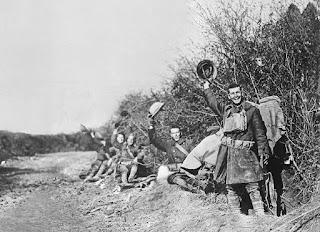 |
| Soldiers on Armistice Day, 1918, AP photo |
We stood up
straight and, God! but it was good!
When you have crouched like that for months, to stand
Straight up and look right out toward No-Man’s-Land
And feel the way you never thought you could.
We saw the
trenches on the other side
And Jerry, too, not making any fuss,
But prob’ly stupid-happy, just like us.
Nobody shot and no one tried to hide.
If you had
listened then I guess you’d heard
A sort of sigh from everybody there,
But all we did was stand and stare and stare,
Just stare and stand and never say a word.
—Hilmar R. Baukhage
Bells rang,
fireworks exploded, whistles blew, and crowds cheered the news of peace in cities,
towns, and villages around the world. Siegfried
Sassoon, invalided out of the war, captures those celebrations of peace in his
poem “Everyone Sang.” But in the trenches, it was the silence that deafened
after years of exploding shells and rattling machine guns. American artillery
officer Captain Bob Casey wrote,
The
silence is oppressive. It weighs in on one’s eardrums. We have lived and had
our being in din since we left the Forêt de la Reine. There seems to be
something uncanny—unnatural in the all-enveloping lack of sound…. The air is
full of half-forgotten sounds: the rustling of dead leaves, the organ tone of
wind in the tree tops, whispers through the underbrush, lazy echoes of voices
in the road…. it can’t be true…We cannot comprehend the stillness.††
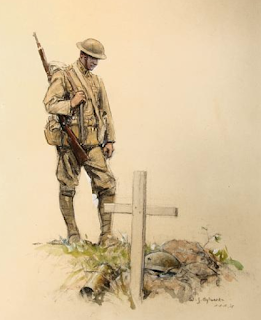 |
His Bunkie by WJ Aylward
Smithsonian AF25661 |
Captain Harry
Truman (the future U.S. president) said, “It was so quiet it made me feel as
I’d suddenly been deprived of my ability to hear,”° while Connell Albertine of
the 26th Yankee Division remembered, “We ran out into No-Man’s Land
and stood there, stunned by the quiet, a quietness we had never before
experienced.”°°
Soldiers found
it hard to celebrate the peace without remembering those who would never return
home. British Lieutenant Patrick Campbell wrote,
I
felt excited, and happy, but in an uncertain subdued way. I did not want to
shout or to drink; there was nothing to drink anyway. I wanted to be with my
friends, but none of those of my age were left in the brigade.°°°
It had been an
indescribable war, and words were inadequate to describe its end. For many soldiers
at the front, when the eleventh hour finally arrived, they could do nothing but
stand and stare.
-------------------------------------------------------------------------------------------------------
* Joseph E.
Persico, Eleventh Month, Eleventh Day,
Eleventh Hour. Random House, 2004, pp 378-379.
** Persico, Eleventh Month, p. 322.
*** Quoted in History of Buffalo and Erie County,
1914-1919. Edited by Daniel J. Sweeney.
† Robert Lee
Bullard, Personalities and reminiscences
of war. Doubleday, 1925, p. 304.
†† Robert J.
Casey, The Cannoneers Have Hairy Ears, J.H.
Sears, 1927, pp. 329-330.
° Persico, Eleventh Month, p. 352.
°° Connell
Albertine, Yankee Doughboy, Branden
Press, 1968, p. 234.
°°° Quoted in
John Toland’s No Man’s Land, Doubleday,
1980, p. 577.
 The scarlet
poppies in “The Harvest” do not bloom or wave in the fields – they run in the
way that blood runs on battlefields. And
during the war, food was deeply connected with fighting. Citizens were reminded of the fact in the rationing
posters that were everywhere:
The scarlet
poppies in “The Harvest” do not bloom or wave in the fields – they run in the
way that blood runs on battlefields. And
during the war, food was deeply connected with fighting. Citizens were reminded of the fact in the rationing
posters that were everywhere:



